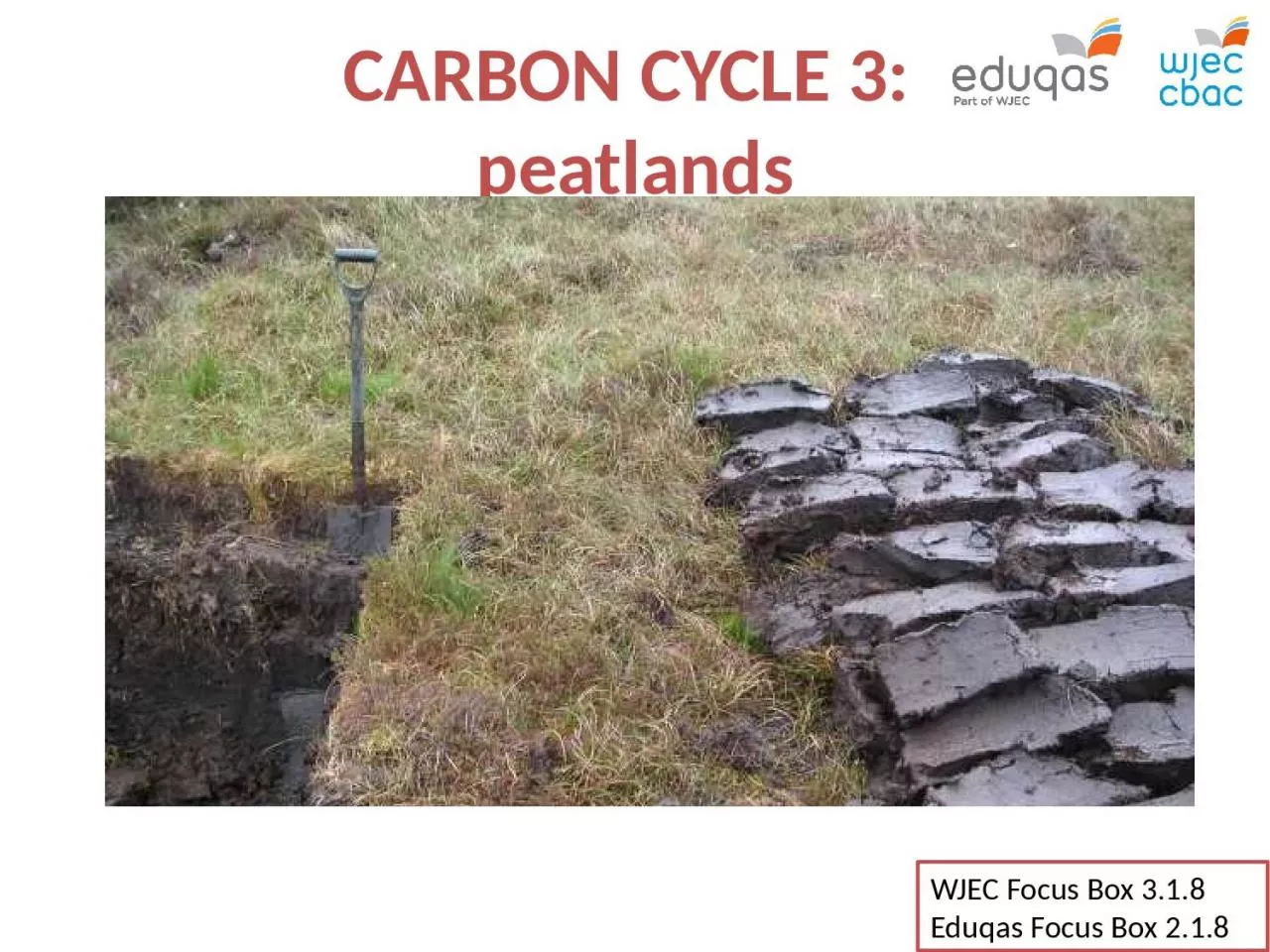

WJEC Focus Box 318 Eduqas Focus Box 218 Carbon Cycle 3 Peat formation Peat is a thick layer of black or dark brown sticky and wet soil material containing very high levels of partially ID: 1024895
Download Presentation The PPT/PDF document "CARBON CYCLE 3 : peatlands" is the property of its rightful owner. Permission is granted to download and print the materials on this web site for personal, non-commercial use only, and to display it on your personal computer provided you do not modify the materials and that you retain all copyright notices contained in the materials. By downloading content from our website, you accept the terms of this agreement.
1. CARBON CYCLE 3: peatlandsWJEC Focus Box 3.1.8Eduqas Focus Box 2.1.8
2. Carbon Cycle 3Peat formationPeat is a thick layer of black or dark brown sticky and wet soil material containing very high levels of partially decomposed vegetation (mosses, rushes, sedges and bracken) The carbon-rich plant remains are slowly compressed as more material is added each year until; in the UK, peat is sometimes 2-4 metres deep Class discussionHave you ever visited a peatland environment? Have you heard of peat being used for gardening or food production?
3. Carbon Cycle 3Anaerobic conditionsDecomposition is prevented by waterlogging, which creates oxygen-deficient anaerobic conditionsThis limits microbial decomposition of organic matter, especially in cooler upland sitesOccasionally, recognisable animal remains from thousands of years ago are found preserved in peat. In 1984, a 2,000-year-old well-preserved human body was found buried in Wilmslow, Cheshire (the media named him ‘Pete Marsh’)Class research taskFind out more about ‘Pete Marsh’ https://www.youtube.com/watch?v=GN6nJGQpcSc
4. Carbon Cycle 3Differing types of peat Class activityThink about topic linkages between the water cycle and the formation of peat (and carbon storage)Fen peatlands form where groundwater meets the surface – at springs or the edge of open water Blanket peatlands occur on flat hill tops where rainfall is highRaised bogs occur in valley bottoms where soils are saturated, due to the frequent arrival of throughflow and overland flow from the slopes above Peatlands are landscapes where layers of peat have accumulated. Globally, peatlands cover many hundreds of square kilometres, with thicknesses of 10 metres or more
5. Carbon Cycle 3Carbon storage in peatClass activityResearch peat resources in Wales: https://www.forestry.gov.uk/fr/INFD-8Z7BSH orThere is a net accumulation of carbon over time in undisturbed peatland: the rate at which atmospheric carbon is fixed in new peatland plants by photosynthesis greatly exceeds the loss of carbon through decompositionDespite only covering 5 per cent of the land area of Wales, deep peatland soils represent 30 per cent of the country’s total soil carbon storageGlobally, peatlands store 550 billion tonnes of carbon
6. Carbon Cycle 3Peat extraction: carbon storage lossOnly 20 per cent of UK peatlands are not degraded and remain in a pristine stateRates of carbon sequestration in degraded peatlands are reduced; they may even become sources of carbon emissions insteadPeat has been dried and burned traditionally in many rural areas as a fuel sourcePeat is extracted for use in garden centres, and food and drink industries (smoked food)Class activityFind out how peat is used in whisky production: https://www.whisky.com/information/knowledge/tasting/flavour/peat-and-its-significance-in-whisky.html
7. Carbon Cycle 3Peat extraction: carbon storage lossThis historical image shows peat extraction in Somerset in 1905Class activityThink about topic linkages between studies of peat extraction and Changing Places (unit/component 1)
8. Carbon Cycle 3Peat drainage and land use changeClass activityResearch these activities further and discuss the relative severity of their impacts on carbon storage Drainage Around one quarter of English peatland is under cultivation; from 1640 onwards the East Anglian fens, were drained for farming. This produced good agricultural land but degraded the peatPollution Peatlands in Yorkshire have been subjected to decades of pollution from Manchester and Sheffield, harming peat-forming plant speciesBurning Large areas of peatlands throughout the UK are affected by moorland burning. This is a widespread land management practice in upland areas for the management of game, such as grouseForestryPeatlands drained by the Forest Commission will begin to emit CO2 and lose some soil carbon via leaching and erosion, but this may be offset over time by the CO2 captured by the growing trees
9. Carbon Cycle 3Carbon storage lossThe table shows how different human activities affect carbon capture and release in peat environmentsClass activityDiscuss reasons for the changes shown in the table aboveLand use (in peatland areas)Net carbon flux (tonnes of CO2 per hectare per year)Cultivated & temporary grass 22.4 net lossImproved grassland 8.7 net lossRotationally burnt 2.6 net lossAfforested 2.5 net lossBare peat 0.1 net lossOvergrazed 0.1 net lossUndamaged 4.1 net storage
10. Carbon Cycle 3Peatland restoration (1)Restoration efforts usually include:the re-establishment of a plant cover dominated by peatland species including sphagnum mossesthe re-wetting of drained peatlands by raising and stabilizing the local water table Class activityResearch examples of peatland restoration in England or Wales: http://www.wildlifetrusts.org/peatlandsPeatland restoration could help the UK meet reduction targets for long-term greenhouse gas emissions - by offsetting emissions produced by economic activity
11. Carbon Cycle 3Peatland restorationSouthern Pennines peatlands in Yorkshire were extensively drained and eroded in the past Recently, erosional gullies have been blocked with stone dams to raise the water table and restore anaerobic conditionsNew seeds and fertilizer are scattered using helicoptersPhotograph shows gullies which have been blocked deliberately in order to promote water retention
12. Carbon Cycle 3PlenaryPeat formation takes thousands of years. Peatlands are located in poorly-drained sites throughout the UKUndisturbed peatlands serve as a carbon sink but land-use changes and peat cutting have led to the degradation of the majority of UK peatlands: most no longer function effectively as carbon stores and have become carbon sources insteadPeatland restoration in the UK and elsewhere can be a valuable way of reducing net carbon emissionsManagement strategies for peatland restoration include re-wetting and the reintroduction of wetland species